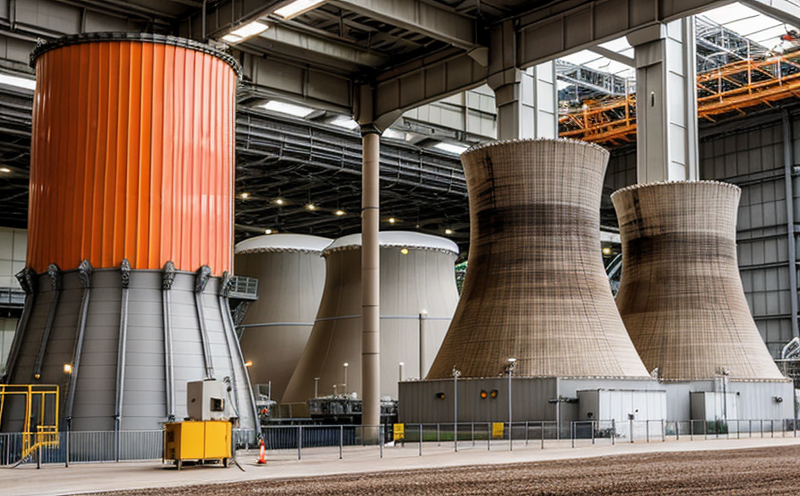ASTM E1681 Stress Corrosion Cracking Testing of Reactor Alloys
The ASTM E1681 standard provides a method to assess stress corrosion cracking susceptibility in reactor alloys. This testing is critical for the nuclear power industry as it ensures that materials used in reactor components meet stringent safety and performance standards.
Stress Corrosion Cracking (SCC) occurs when a material undergoes crack formation due to the combined effect of mechanical stress and corrosive environment. Reactor alloys are often subjected to high temperatures, pressure, and aggressive corrosion environments during nuclear reactions. This can lead to SCC, which can compromise structural integrity and lead to catastrophic failures.
ASTM E1681 specifies a laboratory test method for evaluating the susceptibility of reactor alloys to stress corrosion cracking in chloride-containing aqueous solutions. The testing procedure involves subjecting specimens under tensile stress while exposed to a specific environment that promotes SCC. This ensures that materials selected for use in nuclear reactors are resistant to such harmful conditions.
The test is performed at various temperatures, with the temperature range typically spanning from 10°C to 35°C. The chloride concentration and pH level of the solution can also be adjusted depending on the specific material being tested. This allows for a comprehensive evaluation of how different environmental factors affect SCC susceptibility in reactor alloys.
Specimen preparation is critical for obtaining accurate results. Typically, specimens are cut from nuclear grade materials intended for use in reactor components such as pressure vessels, steam generators, and piping systems. Specimens may be either flat or cylindrical, depending on the specific material being evaluated. They are subjected to tensile stress using a universal testing machine (UTM) while immersed in the test solution.
Once the specimens have been tested according to ASTM E1681, detailed visual and metallurgical analysis is conducted. Visual inspection checks for any visible cracks on the surface of the specimen. Metallurgical examination involves cross-sectional polishing, etching, and microstructural characterization using optical or scanning electron microscopy (SEM). These analyses help determine the presence, location, and extent of SCC.
The testing results are reported according to ASTM E1681 specifications, which include detailed descriptions of the test conditions used, specimen preparation details, visual inspection findings, metallurgical examination results, and any other relevant information. This ensures that all stakeholders involved in nuclear reactor design and manufacturing have a clear understanding of the materials’ SCC susceptibility.
ASTM E1681 is widely recognized as an authoritative standard for evaluating stress corrosion cracking in reactor alloys. It provides a consistent and reproducible method for testing, ensuring that the results are reliable and comparable across different laboratories and facilities.
Why It Matters
Testing reactor alloys according to ASTM E1681 is crucial because it helps prevent catastrophic failures in nuclear power plants. By identifying materials susceptible to SCC early on, manufacturers can take corrective actions such as modifying alloy compositions or changing manufacturing processes.
The importance of this testing cannot be overstated given the significant risks associated with SCC in reactor components. A single crack could lead to a breach in containment structures, potentially causing radioactive leaks and endangering public safety. Ensuring that materials used in these critical systems are resistant to SCC helps maintain the integrity of nuclear facilities and protects against such hazards.
Moreover, compliance with ASTM E1681 is often a regulatory requirement for manufacturers supplying components to nuclear power plants. Regulatory bodies like the U.S. Nuclear Regulatory Commission (NRC) mandate that materials used in these systems must pass rigorous testing standards like ASTM E1681 before being approved for use.
By adhering to this standard, nuclear reactor manufacturers can demonstrate their commitment to quality and safety, thereby enhancing their reputation among clients and stakeholders. This also helps build trust with regulatory authorities, ensuring smoother approval processes and reduced risk of recalls or product liability issues.
Industry Applications
Nuclear power plant pressure vessels, which must withstand high pressures and temperatures while exposed to aggressive corrosion environments.
Steam generators that transfer heat from the reactor core to a secondary circuit where it is used to generate steam for electricity generation. These components are subject to both mechanical stress and corrosive conditions due to the presence of water and dissolved salts.
ASTM E1681 testing plays a vital role in ensuring that these critical components remain intact throughout their operational lifetimes, thereby contributing significantly to overall nuclear safety.
Eurolab Advantages
EuroLab offers unparalleled expertise and advanced facilities for ASTM E1681 stress corrosion cracking testing of reactor alloys. Our team of experienced professionals ensures that every test is conducted meticulously, following all relevant international standards including ASTM E1681.
We utilize state-of-the-art equipment such as universal testing machines (UTMs), optical microscopes, and scanning electron microscopes (SEMs) to perform these tests accurately. Our facilities are equipped with temperature-controlled chambers capable of replicating the exact conditions specified in ASTM E1681.
Our commitment to quality extends beyond just performing the test; we also provide comprehensive reporting services that include detailed descriptions of all test parameters, visual inspection findings, and metallurgical examination results. This ensures full transparency and traceability throughout the testing process.





